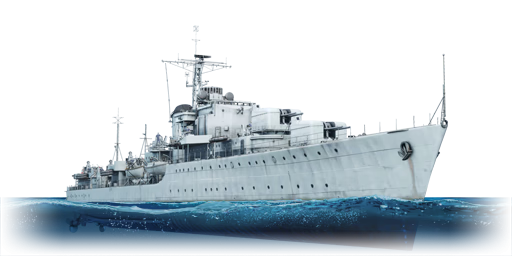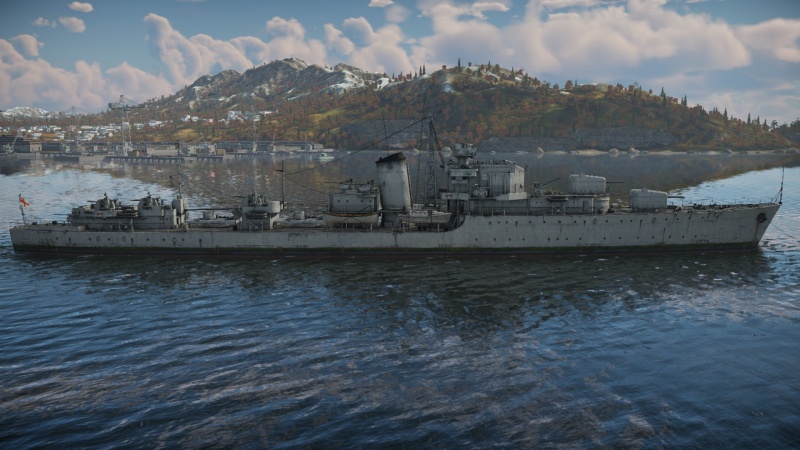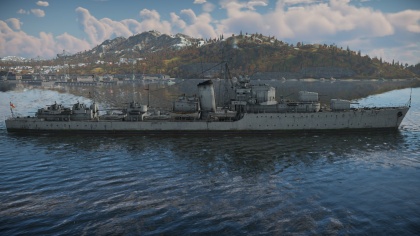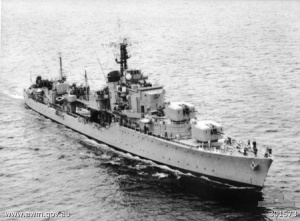Difference between revisions of "HMAS Tobruk"
Bonisducks (talk | contribs) (→History: History and references) (Tag: Visual edit) |
|||
| Line 99: | Line 99: | ||
== History == | == History == | ||
| − | + | <!-- Describe the history of the creation and combat usage of the ship in more detail than in the introduction. If the historical reference turns out to be too long, take it to a separate article, taking a link to the article about the ship and adding a block "/History" (example: https://wiki.warthunder.com/(Ship-name)/History) and add a link to it here using the main template. Be sure to reference text and sources by using <ref></ref>, as well as adding them at the end of the article with <references />. This section may also include the ship's dev blog entry (if applicable) and the in-game encyclopedia description (under === In-game description ===, also if applicable). -->[[File:HMAS Tobruk (AWM 301573).jpg|thumb|HMAS Tobruk in Jervis Bay, circa. 1954-1958. Note the two Mk VI gun turrets ahead of her superstructure.]] | |
| + | The Battle Class, HMAS ''Tobruk'' was a destroyer of the Battle class commissioned for the Australian navy. As one of the two-ship “Australian Battle” class, she featured an improved main armament and more advanced gunnery equipment. She was commissioned too late to see service in the Second World War, but served in the Korean war and Malayan Emergency. She was severely damaged in a gunnery accident in 1960, and was written off and sold for scrap. | ||
| + | |||
| + | === Design and development === | ||
| + | The Battle class, the predominant late-war British destroyer design before the emergence of the Daring class, was designed to be built in several flotillas. The 1943 “Battles” were thus known as the “Early Battle Class”. The United Kingdom intended to build the later Battle class ships with the new QF 4.5 inch Mark VI turret, but these ships were cancelled in early 1945 due to the end of hostilities in the western theatre. However, two ships had been laid down by the Australian navy, which were built and completed nevertheless, to be known as the “Australian Battle” Class ships. Construction was very slow, and ''Tobruk'' wasn’t commissioned until the early 1950s. | ||
| + | |||
| + | HMAS ''Tobruk'' displaced 3400 tons full, making her very large for a WWII-era destroyer. She carried a main armament of four 4.5 inch QF Mark VI guns in two twin turrets - these advanced turrets were capable of firing at 20 rounds per minute (RPM). Tobruk carried an anti-aircraft armament of twelve 40 mm Bofors guns in three dual and six single mounts, as well as two quintuple torpedo tubes. Fitted with steam turbines developing 50 000 shaft horsepower, she was able to make 31.5 knots (58 km/h). | ||
| + | |||
| + | === Operational history === | ||
| + | After her commissioning in 1951, ''Tobruk'' was deployed to the Korean Theatre to assist naval operations there, primarily serving as a shore bombarder and carrier escort. She returned to Australia in late 1952 for a refit, then deployed to Korea again, this time staying until 1954. After she returned home, ''Tobruk'' underwent a refit, and was deployed as part of an Australian naval squadron to southeast Asia (the Far East Strategic Reserve). She later served during the Malayan Emergency, and received a second battle star (her first in Korea) for it. In September of 1960, ''Tobruk'' was conducting exercises with her sister ship ''Anzac'' when a targeting error caused a shell from ''Anzac'' to hit her; the damage was severe, and two of ''Anzac’s'' crew members were charged for the accident. It was deemed that the damage was uneconomical to repair, and as a result, ''Tobruk'' was placed in reserve and later scrapped. | ||
== Media == | == Media == | ||
| Line 118: | Line 127: | ||
* [[wt:en/news/6487-development-hmas-tobruk-advance-australia-en|[Devblog] HMAS Tobruk: Advance Australia!]] | * [[wt:en/news/6487-development-hmas-tobruk-advance-australia-en|[Devblog] HMAS Tobruk: Advance Australia!]] | ||
| + | === References === | ||
| + | |||
| + | * Royal Australian Navy. (2020, August 05). HMAS Tobruk (I). Retrieved January 04, 2021, from <nowiki>https://www.navy.gov.au/hmas-tobruk-i</nowiki> | ||
{{Britain destroyers}} | {{Britain destroyers}} | ||
Revision as of 19:35, 4 January 2021
Contents
Description
The Battle-class, HMAS Tobruk (D37), 1950 is a rank III British destroyer
with a battle rating of 4.7 (AB/RB/SB). It was introduced in Update 1.95 "Northern Wind".
General info
Survivability and armour
Talk about the vehicle's armour. Note the most well-defended and most vulnerable zones, e.g. the ammo magazine. Evaluate the composition of components and assemblies responsible for movement and manoeuvrability. Evaluate the survivability of the primary and secondary armaments separately. Don't forget to mention the size of the crew, which plays an important role in fleet mechanics. Save tips on preserving survivability for the "Usage in battles" section. If necessary, use a graphical template to show the most well-protected or most vulnerable points in the armour.
Mobility
Write about the ship's mobility. Evaluate its power and manoeuvrability, rudder rerouting speed, stopping speed at full tilt, with its maximum forward and reverse speed.
Modifications and economy
Armament
Primary armament
Provide information about the characteristics of the primary armament. Evaluate their efficacy in battle based on their reload speed, ballistics and the capacity of their shells. Add a link to the main article about the weapon: {main|Weapon name (calibre)}. Broadly describe the ammunition available for the primary armament, and provide recommendations on how to use it and which ammunition to choose.
Secondary armament
Some ships are fitted with weapons of various calibres. Secondary armaments are defined as weapons chosen with the control Select secondary weapon. Evaluate the secondary armaments and give advice on how to use them. Describe the ammunition available for the secondary armament. Provide recommendations on how to use them and which ammunition to choose. Remember that any anti-air armament, even heavy calibre weapons, belong in the next section. If there is no secondary armament, remove this section.
Torpedo armament
Torpedoes launchers are standard equipment on many ships and boats. Torpedoes are a significant means of defeating an opponent. Evaluate the position of the torpedo launchers, discuss the ammunition available, firing specifics such as dead zones, features of the torpedoes themselves, etc. If there is no torpedo armament, remove this section.
Additional armament
Describe the available additional armaments of the ship: depth charges, mines, torpedoes. Talk about their positions, available ammunition and launch features such as dead zones of torpedoes.
If there is no additional armament, remove this section.
Usage in battles
Describe the technique of using this ship, the characteristics of her use in a team and tips on strategy. Abstain from writing an entire guide – don't try to provide a single point of view, but give the reader food for thought. Talk about the most dangerous opponents for this vehicle and provide recommendations on fighting them. If necessary, note the specifics of playing with this vehicle in various modes (AB, RB, SB).
Modules
| Tier | Seakeeping | Unsinkability | Firepower | |||
|---|---|---|---|---|---|---|
| I | Dry-Docking | Tool Set | 4.5 inch SAP | 40 mm HE clips | ||
| II | Rudder Replacement | Fire Protection System | Smokescreen | 4.5 inch HE-TF | 40 mm AP clips | Auxiliary Armament Targeting |
| III | Propeller Replacement | Shrapnel Protection | Ventilation | Improved Rangefinder | Primary Armament Targeting | |
| IV | Engine Maintenance | New Pumps | Ammo Wetting | 4.5 inch HE-VT | Torpedo Mode | |
Pros and cons
Summarise and briefly evaluate the vehicle in terms of its characteristics and combat effectiveness. Mark its pros and cons in the bulleted list. Try not to use more than 6 points for each of the characteristics. Avoid using categorical definitions such as "bad", "good" and the like - use substitutions with softer forms such as "inadequate" and "effective".
Pros:
Cons:
History
The Battle Class, HMAS Tobruk was a destroyer of the Battle class commissioned for the Australian navy. As one of the two-ship “Australian Battle” class, she featured an improved main armament and more advanced gunnery equipment. She was commissioned too late to see service in the Second World War, but served in the Korean war and Malayan Emergency. She was severely damaged in a gunnery accident in 1960, and was written off and sold for scrap.
Design and development
The Battle class, the predominant late-war British destroyer design before the emergence of the Daring class, was designed to be built in several flotillas. The 1943 “Battles” were thus known as the “Early Battle Class”. The United Kingdom intended to build the later Battle class ships with the new QF 4.5 inch Mark VI turret, but these ships were cancelled in early 1945 due to the end of hostilities in the western theatre. However, two ships had been laid down by the Australian navy, which were built and completed nevertheless, to be known as the “Australian Battle” Class ships. Construction was very slow, and Tobruk wasn’t commissioned until the early 1950s.
HMAS Tobruk displaced 3400 tons full, making her very large for a WWII-era destroyer. She carried a main armament of four 4.5 inch QF Mark VI guns in two twin turrets - these advanced turrets were capable of firing at 20 rounds per minute (RPM). Tobruk carried an anti-aircraft armament of twelve 40 mm Bofors guns in three dual and six single mounts, as well as two quintuple torpedo tubes. Fitted with steam turbines developing 50 000 shaft horsepower, she was able to make 31.5 knots (58 km/h).
Operational history
After her commissioning in 1951, Tobruk was deployed to the Korean Theatre to assist naval operations there, primarily serving as a shore bombarder and carrier escort. She returned to Australia in late 1952 for a refit, then deployed to Korea again, this time staying until 1954. After she returned home, Tobruk underwent a refit, and was deployed as part of an Australian naval squadron to southeast Asia (the Far East Strategic Reserve). She later served during the Malayan Emergency, and received a second battle star (her first in Korea) for it. In September of 1960, Tobruk was conducting exercises with her sister ship Anzac when a targeting error caused a shell from Anzac to hit her; the damage was severe, and two of Anzac’s crew members were charged for the accident. It was deemed that the damage was uneconomical to repair, and as a result, Tobruk was placed in reserve and later scrapped.
Media
Excellent additions to the article would be video guides, screenshots from the game, and photos.
See also
Links to articles on the War Thunder Wiki that you think will be useful for the reader, for example:
- reference to the series of the ship;
- links to approximate analogues of other nations and research trees.
External links
References
- Royal Australian Navy. (2020, August 05). HMAS Tobruk (I). Retrieved January 04, 2021, from https://www.navy.gov.au/hmas-tobruk-i
| Britain destroyers | |
|---|---|
| Town-class | HMS Churchill · HMS Montgomery |
| V-class | HMS Valhalla · HMS Vega · HMS Verdun |
| G-class | HMS Grafton · ORP Garland |
| Hunt-class | HMS Calpe · HMS Brissenden |
| Tribal-class | HMCS Haida · HMS Eskimo · HMS Mohawk |
| J-class | HMS Jervis |
| K-class | HMS Kelvin |
| N-class | HMAS Nepal |
| Battle-class | HMS Armada · HMS Cadiz · HMAS Tobruk |
| Daring-class | HMS Daring · HMS Diamond · HMS Diana |







